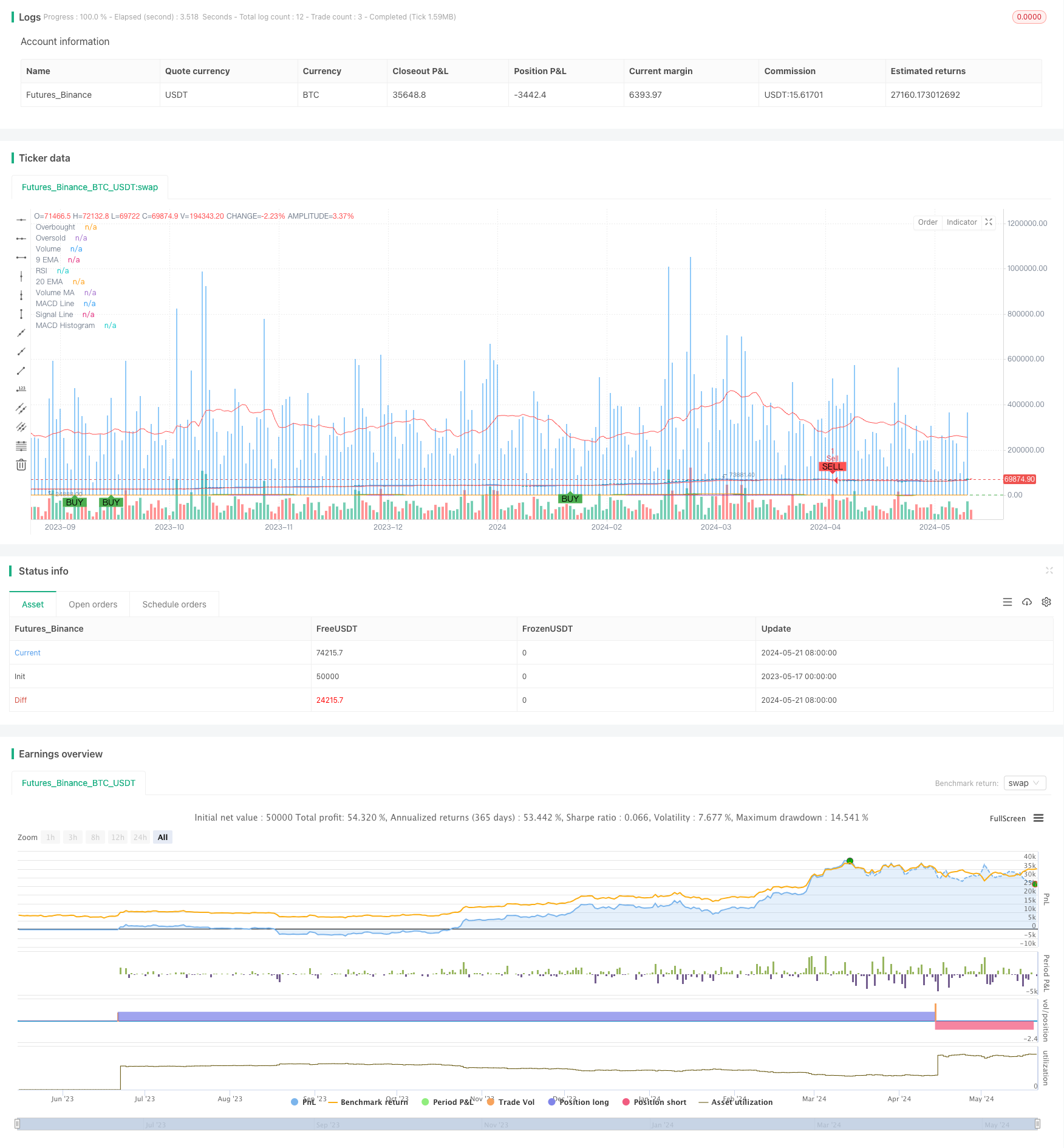
概述
BONK多因子交易策略是一个结合了多个技术指标的量化交易策略。该策略利用了EMA、MACD、RSI和成交量等指标来捕捉市场趋势和动量,并结合止损和止盈机制来控制风险。该策略的主要思路是通过多个指标的共同确认来产生交易信号,以提高交易的准确性和可靠性。
策略原理
该策略使用了四个主要的技术指标:EMA、MACD、RSI和成交量。
EMA(指数移动平均线):策略使用了两条EMA线,分别是9周期和20周期。当短期EMA线上穿长期EMA线时,产生买入信号;当短期EMA线下穿长期EMA线时,产生卖出信号。
MACD(移动平均线聚散指标):MACD由两条线组成,即MACD线和信号线。当MACD线上穿信号线时,表明市场趋势向上,支持买入;当MACD线下穿信号线时,表明市场趋势向下,支持卖出。
RSI(相对强弱指数):RSI用于衡量市场的超买和超卖情况。当RSI高于70时,表明市场处于超买状态,可能面临回调风险;当RSI低于30时,表明市场处于超卖状态,可能出现反弹机会。
成交量:策略使用了20周期的成交量移动平均线。当实际成交量高于平均线时,表明市场活跃度较高,趋势可能会延续。
综合以上四个指标,当EMA、MACD和成交量都支持买入,且RSI未处于超买区间时,策略产生买入信号;反之,当EMA、MACD和成交量都支持卖出,且RSI未处于超卖区间时,策略产生卖出信号。
此外,策略还设置了止损和止盈价位。对于多头交易,止损价位为进场价的95%,止盈价位为进场价的105%;对于空头交易,止损价位为进场价的105%,止盈价位为进场价的95%。这有助于控制单笔交易的风险敞口。
策略优势
多指标共同确认:该策略综合了多个技术指标,包括趋势指标(EMA)、动量指标(MACD)、超买超卖指标(RSI)和成交量指标。通过多个指标的共同确认,可以提高交易信号的可靠性,减少假信号的出现。
趋势跟踪能力:EMA和MACD指标都具有良好的趋势跟踪能力。通过捕捉市场的主要趋势,策略可以顺应市场方向进行交易,提高盈利机会。
成交量确认:策略引入了成交量指标作为辅助判断。在价格信号出现的同时,成交量的放大可以验证趋势的真实性,提高交易信号的可信度。
风险控制:策略设置了明确的止损和止盈价位,有助于控制单笔交易的风险敞口。同时,RSI指标的引入也可以避免在超买或超卖区间进行交易,降低风险。
策略风险
参数优化风险:该策略包含多个参数,如EMA周期、MACD参数、RSI周期等。这些参数的选择会影响策略的表现。如果参数优化过度,可能导致策略在未来的市场环境中表现不佳。
市场环境变化:该策略基于历史数据进行回测和优化,但未来的市场环境可能与历史数据存在差异。当市场出现剧烈波动、突发事件或趋势反转时,策略的有效性可能会下降。
交易频率和成本:该策略可能会产生较高的交易频率,尤其是在市场波动较大的情况下。频繁的交易可能会增加交易成本,如手续费和滑点,从而影响策略的整体表现。
止损和止盈位置:策略使用固定的止损和止盈比例(5%)。这种静态的风险控制方法可能并不适用于所有市场状况。在某些情况下,固定的止损位置可能过于紧凑,导致过早止损;而固定的止盈位置可能限制了策略的盈利潜力。
策略优化方向
动态止损和止盈:考虑使用动态的止损和止盈机制,如基于ATR(平均真实范围)或布林带的止损位置。这可以更好地适应市场的波动性,提高风险控制的有效性。
加入其他指标:可以考虑引入其他技术指标,如布林带、KDJ等,以进一步确认交易信号。此外,可以加入一些宏观经济指标或市场情绪指标,以捕捉更多的市场信息。
参数优化:对策略的关键参数进行定期优化,以适应不断变化的市场环境。可以使用遗传算法、网格搜索等方法来优化参数组合,提高策略的稳健性。
风险管理:引入更高级的风险管理技术,如仓位管理、资金分配等。可以根据市场波动性、账户余额等因素动态调整仓位大小,控制整体风险敞口。
组合策略:将该策略与其他策略组合使用,如趋势跟踪策略、均值回归策略等。通过策略组合,可以实现更好的风险分散和收益平滑。
总结
BONK多因子交易策略是一个基于EMA、MACD、RSI和成交量指标的量化交易策略。该策略通过多个指标的共同确认来产生交易信号,并设置了固定的止损和止盈位置来控制风险。策略的优势在于趋势跟踪能力、多指标验证和风险控制,但也存在参数优化风险、市场环境变化和交易成本等风险。为了进一步改进策略,可以考虑采用动态止损止盈、引入其他指标、参数优化、高级风险管理和策略组合等方法。总的来说,BONK多因子交易策略为量化交易提供了一个可行的框架,但在实际应用中仍需要谨慎评估和不断优化。
/*backtest
start: 2023-05-17 00:00:00
end: 2024-05-22 00:00:00
period: 1d
basePeriod: 1h
exchanges: [{"eid":"Futures_Binance","currency":"BTC_USDT"}]
*/
//@version=5
strategy("BONK Trading Bot with Volume, Stop Loss, and Take Profit", overlay=true)
// Input parameters for EMA
emaShortLength = input.int(9, title="Short EMA Length", minval=1)
emaLongLength = input.int(20, title="Long EMA Length", minval=1)
// Input parameters for MACD
macdFastLength = input.int(12, title="MACD Fast Length")
macdSlowLength = input.int(26, title="MACD Slow Length")
macdSignalSmoothing = input.int(9, title="MACD Signal Smoothing")
// Input parameters for RSI
rsiLength = input.int(14, title="RSI Length")
rsiOverbought = input.int(70, title="RSI Overbought Level")
rsiOversold = input.int(30, title="RSI Oversold Level")
// Calculate EMA
emaShort = ta.ema(close, emaShortLength)
emaLong = ta.ema(close, emaLongLength)
// Plot EMA
plot(emaShort, title="9 EMA", color=color.blue)
plot(emaLong, title="20 EMA", color=color.red)
// Calculate MACD
[macdLine, signalLine, _] = ta.macd(close, macdFastLength, macdSlowLength, macdSignalSmoothing)
macdHist = macdLine - signalLine
// Plot MACD
plot(macdLine, title="MACD Line", color=color.green)
plot(signalLine, title="Signal Line", color=color.orange)
plot(macdHist, title="MACD Histogram", color=color.gray, style=plot.style_histogram)
// Calculate RSI
rsi = ta.rsi(close, rsiLength)
// Plot RSI
plot(rsi, title="RSI", color=color.purple)
hline(rsiOverbought, "Overbought", color=color.red)
hline(rsiOversold, "Oversold", color=color.green)
// Volume Indicator
volumeMA = ta.sma(volume, 20)
plot(volume, title="Volume", color=color.blue, style=plot.style_histogram)
plot(volumeMA, title="Volume MA", color=color.red)
// Define trading conditions
buyCondition = ta.crossover(emaShort, emaLong) and (macdLine > signalLine) and (rsi < rsiOverbought) and (volume > volumeMA)
sellCondition = ta.crossunder(emaShort, emaLong) and (macdLine < signalLine) and (rsi > rsiOversold) and (volume > volumeMA)
// Calculate stop loss and take profit levels
longStopLoss = close * 0.95
longTakeProfit = close * 1.05
shortStopLoss = close * 1.05
shortTakeProfit = close * 0.95
// Execute trades with stop loss and take profit
if (buyCondition)
strategy.entry("Buy", strategy.long, stop=longStopLoss, limit=longTakeProfit)
if (sellCondition)
strategy.entry("Sell", strategy.short, stop=shortStopLoss, limit=shortTakeProfit)
// Plot buy/sell signals on the chart
plotshape(series=buyCondition, title="Buy Signal", location=location.belowbar, color=color.green, style=shape.labelup, text="BUY")
plotshape(series=sellCondition, title="Sell Signal", location=location.abovebar, color=color.red, style=shape.labeldown, text="SELL")